If you’re not that familiar or experienced with amplifiers it can be intimidating trying to understand them. With so many different types of guitar amps, various sizes and speakers, not to mention the almost endless number of brands, it can be confusing!
I found it took me a while to make sense of all the options that are available as well as how they differ and what they’re best suited to. But it was important for making the right choices when buying an amp and getting one that would do what I needed.
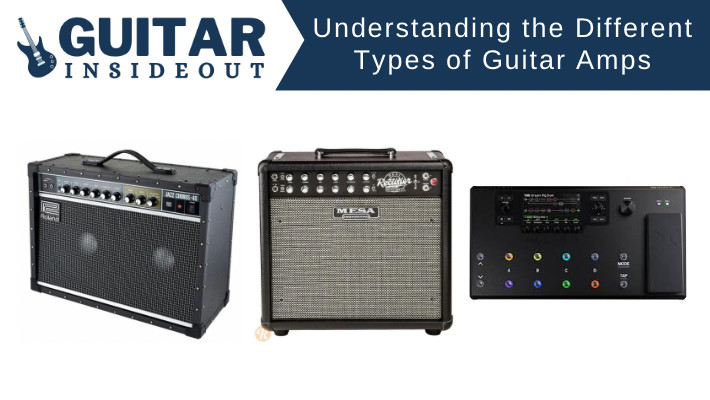
So I get that it can be a bit complicated.
Hopefully this guide will explain the different types of guitar amps in an easy to understand way. We will look at all the kinds of amps, how they compare and differ, the pros and cons of each and more.
Types of Guitar Amplifiers
There are four types of amplifiers that are used by the majority of guitarists. They are tube, modelling, solid state and hybrid amps. Each type of amp is similar but they all sound different due to the way they produce sound and the technology used.
You will also find that all amps come in a variety of different sizes with different speaker configurations and wattages. These play a big role in how the amps sound as well as their volume, headroom and more.
So fully understanding these types of amps is important because it will be the single biggest factor in your sound. When buying an amp you want the right one that gives you the tone you desire.
For example if you’re playing metal you need an amp that gives you a lot of gain. If you’re playing jazz it needs to really excel at cleans and warmth.
There are very few amps that will be suitable for both of those. So knowing what every type of amp does and sounds like will help you to make the best decision for what you need.
Tube Amps
Tube amps, also known as valve amps, take their name from the vacuum tubes that are a major part of where the sound comes from. Those vacuum tubes control the flow of current and amplifies the signal of your guitar whilst adding their own tone.
If you turn the amp up and ‘push’ the tubes then they will begin to break up that signal and distort it, which is what guitarists are often looking for. It’s a distinctive sound and different to the distortion other amp types produce.
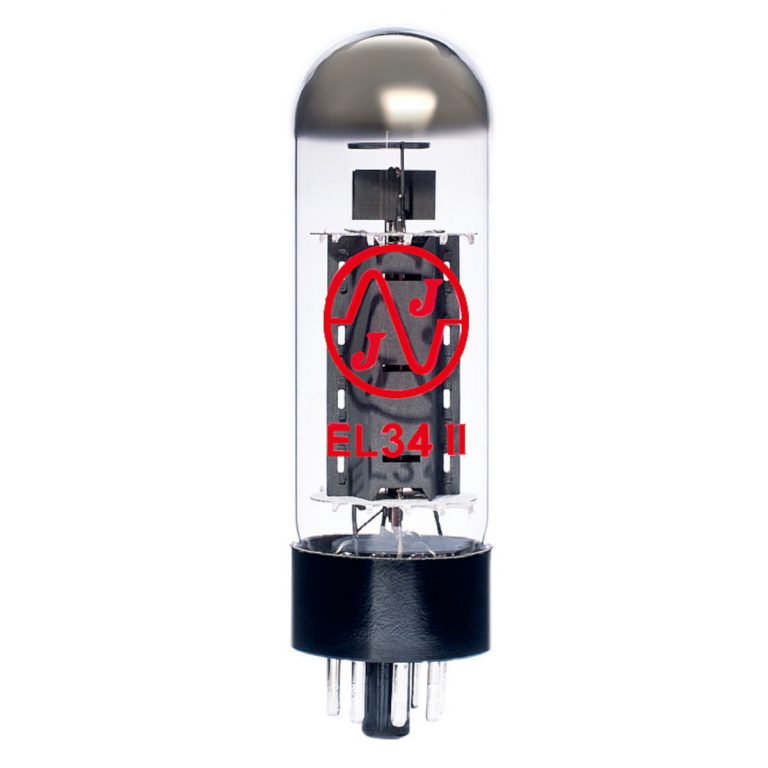
Tube amps are seen as ‘real amps’ by a lot of guitarists who believe them to have a much better tone than all the other types of amps. In fact the love of tube amps can lead to some guitarists being quite snobby and dismissive of the other amps.
There is a long running debate amongst guitarists of tube amps vs solid state or tube amps vs modelling amps. It’s one that doesn’t really have a concrete answer and will no doubt go on for years.
They do have an impressive history however, having been used for many decades, and you will have heard them as part of the most famous songs from across all genres. Technology has come a long way though and we have now transistors (or solid state amps) and modelling options.
But the appeal of a tube amp is still very alive and for recording and playing live the majority of bands and artists still favor tube amps. That may be changing though, as we’ll get to later on.
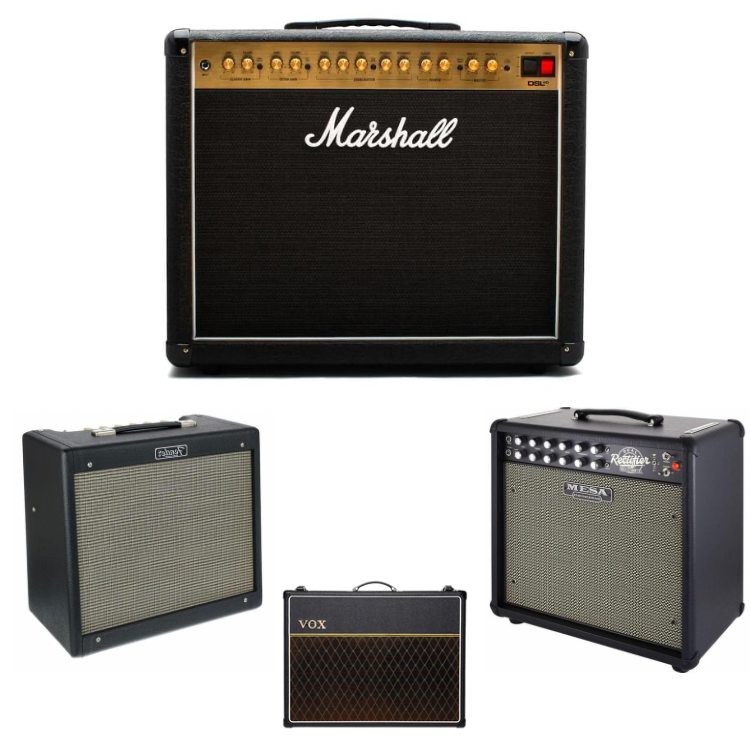
How do They Sound
Why tubes amp are more popular than the alternatives is that a lot of guitarists prefer the sound. The natural break up and distortion you get when you turn the volume up on a tube amp is hard to replicate.
Most solid state and modelling options haven’t really been able to get it right. They get close, and close enough for some people, but not quite there.
That is because of the way tube amps work – the vacuum tubes mentioned earlier – whereas solid state amps don’t have tubes so can never get that same tone you get when the tubes are pushed.
And modelling amps are models based on famous amps, so imitations (albeit very good ones in some cases).
The actual sound itself is more dynamic. It’s hard to explain but tube amps feel sort of organic and “real”. They’re more responsive when you’re strumming and picking in a way that other types of amps just aren’t.
The natural distortion you can get from a tube amp is fuller and more rich. As you turn it up you get a sort of growl that most solid state and modellers don’t.
When it comes to clean tones then many solid state options are just as good as tube amps. There are a few solid state amps, like the Roland Jazz Chorus, that are actually preferred by some artists and bands.
But it’s all subjective and there are still lots of guitarists who like or prefer other amps than tubes.
Weight
Tube amps are almost always heavier than every other type of amp. Usually by a big margin.
In fact one of the biggest drawbacks of tube amps is their weight. This is especially true for gigging musicians.
Hauling a heavy weight amp from gig to gig or for rehearsals can be a real struggle. Even hugely popular bands and artists have started to move away from using tube amps for live gigs because of the issues with transporting them and how expensive it is.
Metallica, Dream Theater, Def Leppard, 30 Seconds to Mars, Weezer as well as the likes of Rihanna and Lady Gaga’s guitarists, to name just a few, use modelling amps like the Fractal Axe-Fx and Kemper profiling.
You can grab a modelling unit like the Line 6 Helix or Kemper in one hand whereas moving a tube amp long term is a sure fired way to develop back problems! And the cost of moving a large bands entire gear – multiple big heavy tube amps, speaker cabinets, pedal boards etc. – costs a ton.
If you’re only playing at home or leaving it in a practice space for rehearsing then it’s not really a problem. But if you need to move your amp at all then a big consideration when buying a tube amp should be the weight and how difficult you will find transporting it.
As a quick example a Fender Twin Reverb with two 12″ speakers, a very popular amp with touring bands and artists, weighs roughly 73 – 88lbs (31 – 40kg). In comparison the Boss Katana MkII 2×12″ weighs roughly 44kbs (20kg), so almost half the Twin Reverb! And a modelling amp or profiler like the Line 6 Helix LT weighs as little as 14-15 lbs (6 – 7kg).
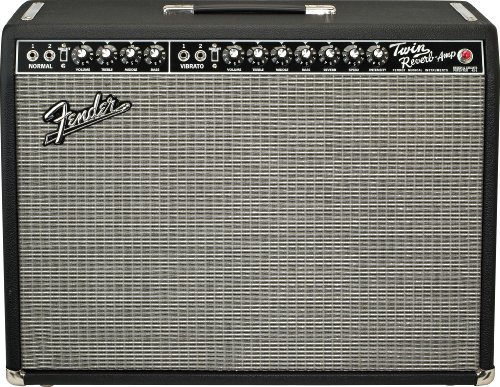
Reliability
Due to the way tube amps are made and work they are more susceptible to problems than solid state or modelling amps. The tubes themselves are fragile and can break quite easily.
It means you have to handle them with some care. They’re usually built well but in comparison to their sold state counterparts they are more likely to get damaged. Mainly because of the tubes.
As solid state amps don’t have tubes they are less likely to break.
There are some solid state amps that are known for being virtually indescribable. The Peavey Bandit has a reputation of withstanding almost anything you can throw at it.

Also tubes need replacing from time to time just from general use (see this article for how long they last). Again, this is different to solid state and modelling amps which don’t have any parts that wear out.
How Much Do They Cost
Tubes amps tend to be more expensive than most other types of amps. There are some very high end modelling and solid state options but the majority of those types of amps will be cheaper than tube amps.
Much of the extra cost is to do with the components that go into tubes amps and the circuitry involved. It’s all more complex which means it’s more expensive to produce and so in turn the price of the amp goes up.
Pro’s of Tube Amps
- Arguably the best sound and tone come from tube amps.
- More natural sounding distortion.
- Simple and straightforward to use.
- Greater dynamics and harmonics in their sound.
Con’s of Tube Amps
- Heavier and more difficult to transport.
- More expensive.
- Less reliable and more fragile.
- Need to be played loud to really sound good.
- Not as many options for beginners or playing at home.
- Some can be limited in the tones they are capable of.
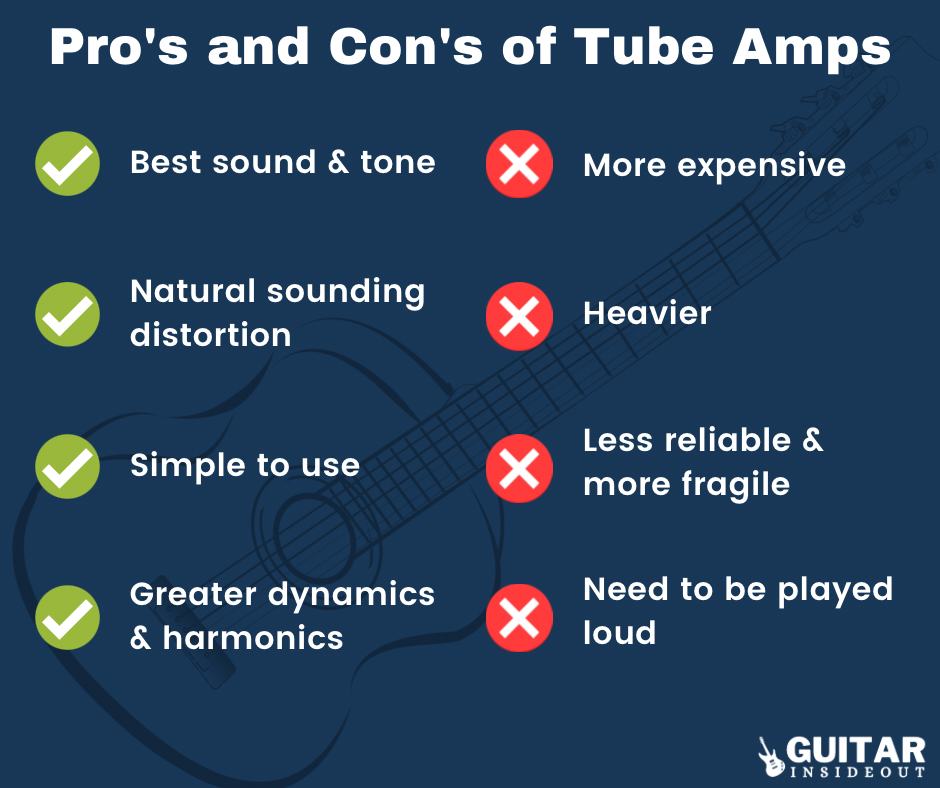
Solid State
Solid state amps use a different technology to the other amps listed here – transistors. Transistors are used instead of tubes and that means they do a few things differently.
For starters transistors are much smaller than tubes and require different circuitry. This leads to a fairly large reduction in the weight of the amp.
They also don’t have the issue of burning out like tubes do. Tubes require replacing even when they haven’t broken.
General use wears them out over time, so you need to buy new ones. Transistors can last forever (assuming they don’t get broken).
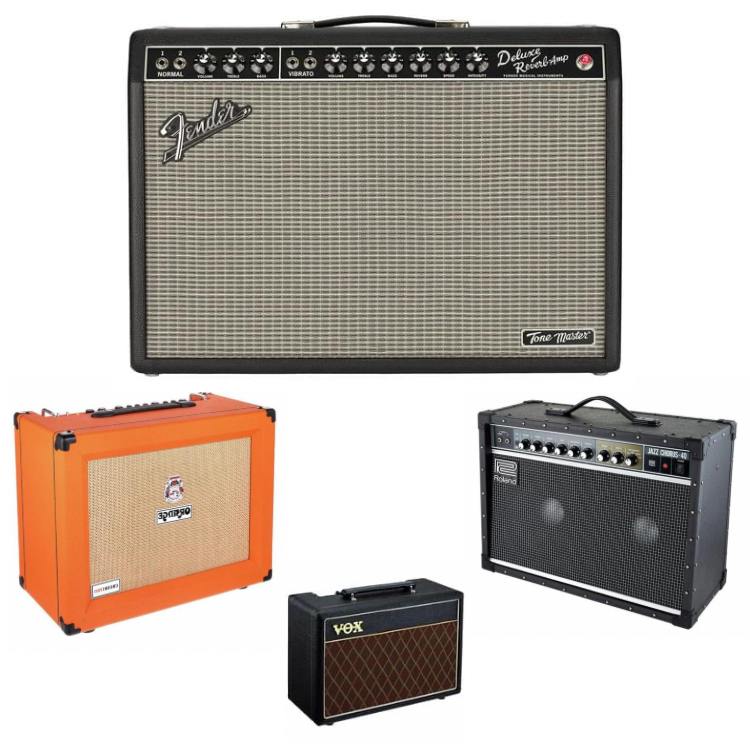
How do They Sound
One of the benefits of a solid state amp is that you can get a very loud but completely clean sound – a lot of clean headroom. With tube amps when you turn them up the tubes begin to break up and distort which means you can struggle to keep a very clean tone at higher volume. Solid state amps don’t have this problem.
That is why some genres of music, like jazz, sometimes prefer solid state amps. Needing a very clean tone with no distortion makes solid state the perfect choice.
The Roland Jazz Chorus is considered one of the best solid state amps for this reason. It gives sparkling and incredible clean tones that only a few of the top tube amps can match.
It’s not all positive though. Some people feel this sound can be sterile and lifeless. Solid state amps are seen as having very little in the way of personality and a bland tone.
They also don’t do nearly as well when it comes to high gain. You can’t get any of the characteristics and warmth that a tube amp produces when it distorts.
There are a few exceptions – for certain death metal bands that like a sort of buzzsaw type of distortion solid state amps do a good job. But for the most part bands and artists that want any amount of gain will choose a tube amp.
Most solid states don’t take pedals well either.
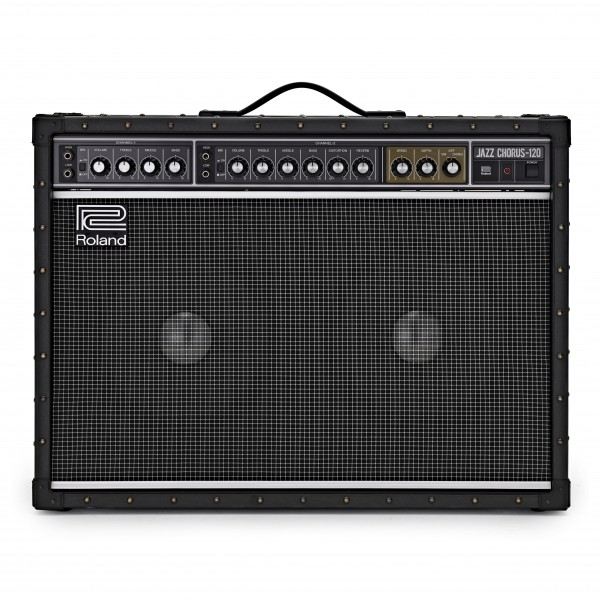
Weight
As mentioned earlier solid state amps are mostly much lighter than tube amps. This is due to the lack of tubes and the components and circuitry that is needed to work them.
Tube amps also have power and output transformers which both add weight. Often the hardshell is made from wood and the chassis is thicker too.
Basically there are a greater number of parts in a tube amp that contribute to the overall weight. Parts that solid state amps don’t have and so don’t get weighed down by.
Reliability
Solid state amps and modelling amps don’t require the maintenance that tube amps do. Tubes needs changing somewhat regularly, especially if you’re gigging, and they break quite easily too.
Solid state amps though don’t have parts that need changing. If they’re treated well then in decades time you can find they are still working. The same applies to modellers too.
How Much Do They Cost
The majority of solid state amps are cheaper than tube amps. Modelling amps vary a lot more with some being very expensive and some being much cheaper
The reason that solid state amps are cheaper is that the components used to construct them are fairly inexpensive and they use fewer of them. Tube amps in comparison use lots of parts which can be expensive, so the cost is passed on to the consumer.
The technology behind modelling amps can be very cutting edge which makes them expensive too. But it depends on the amp.
The Line 6 Helix is a very advanced piece of gear using the most up to date modelling technology. In comparison something like the Fender Mustang LT is a small and affordable practice amp that uses amp modelling too just not nearly as advanced. Unsurprisingly the Helix is far more expensive.

Pro’s of Solid State Amps
- Much more affordable than other types of amps.
- Usually more reliable and less likely to break.
- They don’t need as much maintenance and upkeep as tube amps.
- Lots of clean headroom.
- Weigh far less than tube amps.
Con’s of Solid State Amps
- Poor distorted tone.
- Lack of versatility, especially with the advance modelling amps have made.
- Many don’t take pedals well.
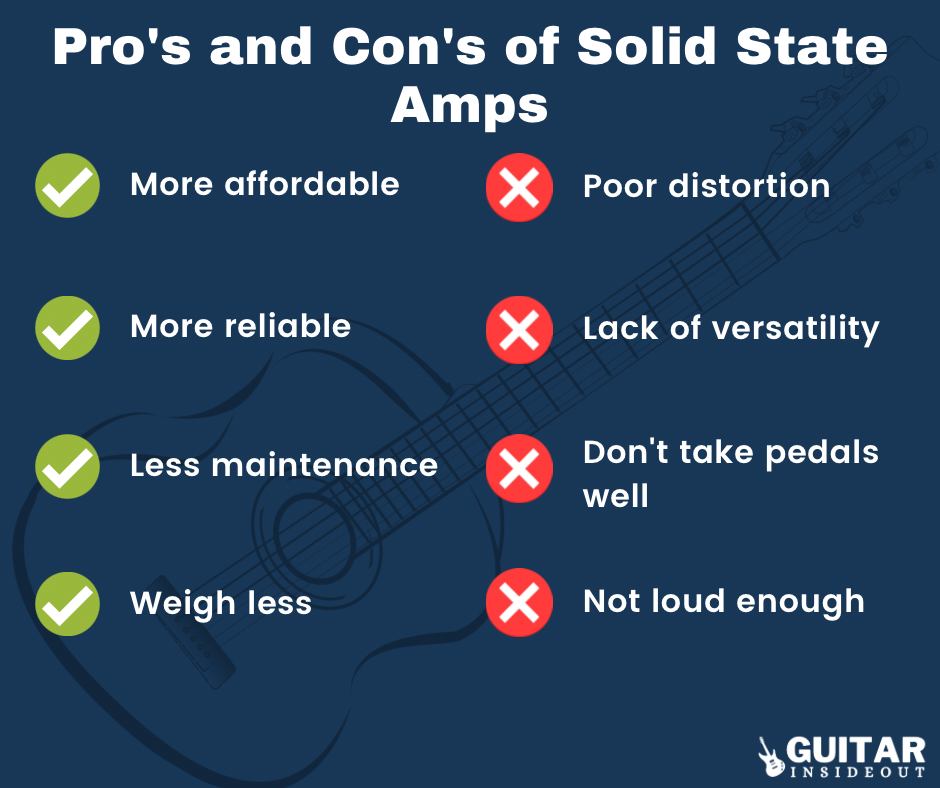
Modelling
Modelling amps are sort of a step up from solid state amps. But instead of producing regular guitar tones like clean and distorted what modelling amps do is recreate the tone of specific amps and effects.
So a modelling amp might have a database of a variety of amp models that you can select. You pick which one you want and then the sound that comes from the amp is a recreation of whichever amp you chose.

Let’s say you want to play some really heavy metal – you’d need a high gain amp. On your modeller you look through the options and see it has a Mesa Boogie Triple Rectifier or Peavey 6505 amp model.
You select one of those and you get a modelled version of that amp and how it sounds. It’s replicates the high gain you would get from that amp as if you were using it.
Then you want to switch to playing jazz. So you go through the options and see there is a Roland Jazz Chorus or a Fender Princeton. You select one and get a lovely clean tone that is based on whichever of those amp models you’ve chosen.
The same applies with effects. Many modelling amps can recreate tube screamers, flangers, phasers, delay pedals and more.
The idea behind it is that one amp can then replicate a huge range of tones and effects. It sounds great, right? Having the option to get virtually any sound or tone from just one amp.
But when these modellers were first introduced there were issues. How can I put it gently… they were dreadful.
I had a Line 6 Spider from 2005 and it was terrible (part of the reason Line 6 developed their reputation). It had loads of presets that bands and artists had apparently dialled in to recreate the tones from their famous songs and albums.
But most of them were really bad. Especially the higher gain ones.
I’m pleased to say that technology has come a long way since then! Things are much, much better.
Nowadays it can be difficult to tell the difference between some of the best modellers and the amps they are based on. And that’s when you know what the original sounds like and what to listen for. To those who aren’t particularly interested in guitars and amps, which is most people, they’re not going to be able to notice the small differences.
It’s why more and more bands are using modelling amps when playing live. You get close enough to the real thing so that only the most experienced guitarists or audiophiles will know. The rest of the crowd won’t have a clue and, frankly, won’t care!
And even the smaller modelling amps aimed at beginners and home players have made leaps and bounds. The likes of the BOSS Katana, an affordable modelling amp perfect for using at home, has had rave reviews from everyone about how good it sounds.
With the technology still evolving and improving we can expect to see modelling amps getting even better. It won’t be long before the minor differences there are between tube amps and the best modellers is gone entirely and no one will be able to tell them apart.

Boss Katana-50 MkII 1 x 12-inch 50-watt Combo Amp
How do They Sound
It really depends on the modelling amp you get. As an example the Fender Mustang LT is a fine practice amp and great starting point for beginners. But will it’s models rival the proper tube versions? Unfortunately not.
But if you go up to the higher end tech with things like the Line 6 Helix and Kemper you are going to be rivalling the best amps on the market. You can expect fantastic tones that are hard to distinguish from the real thing.
So it depends on what modeller you go for.
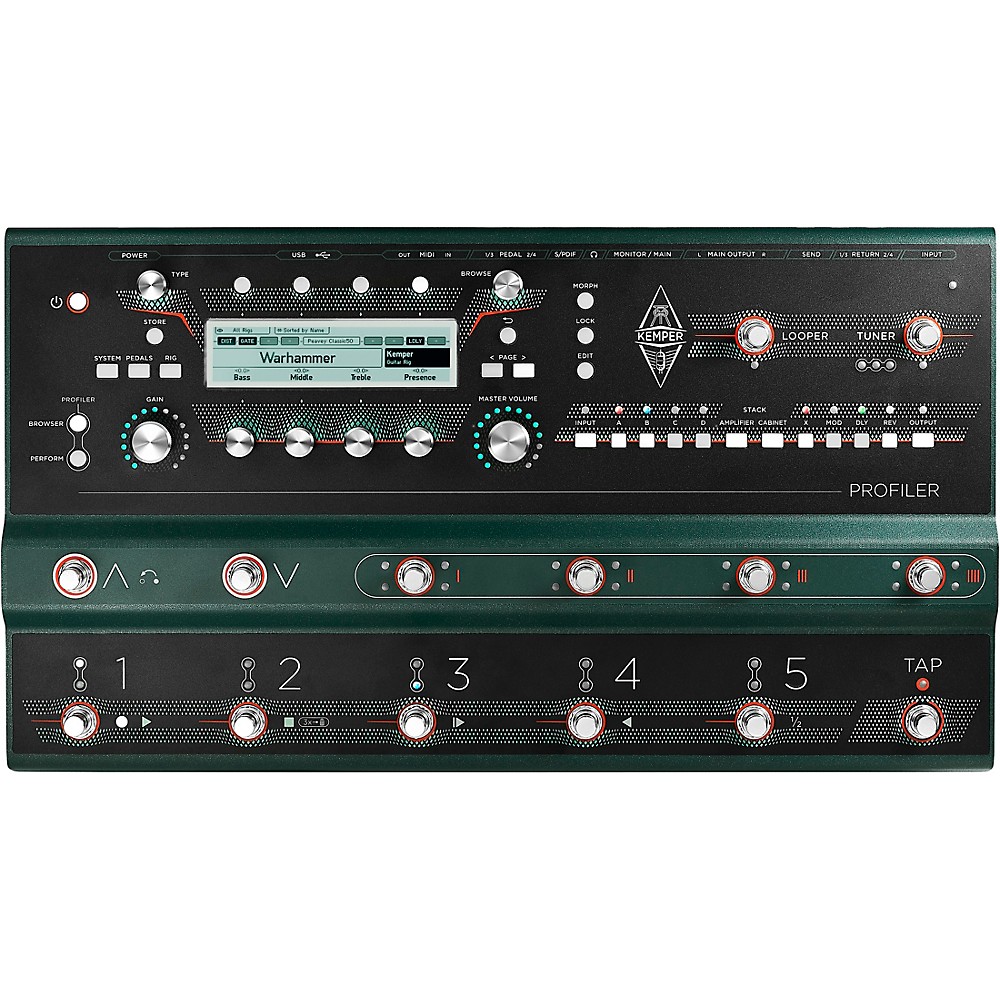
Weight
Out of tube, solid state and modelling amps then the modelling amps are the lightest. The BOSS Katana with a 12″ speaker is one of the most popular modelling amps and weighs 26lbs (12kg). In comparison my Orange Rocker 15 with only a 10″ speaker weighs 30lbs (13.6kg).
So even with a smaller speaker the tube amp is overall heavier.
And using another Orange – the solid state Crush 60 which also has a 12″ speaker – weighs 48lbs (22kg). So out of the three the Katana, a modelling amp, is the lightest.
Reliability
Digital modelling amps are as reliable as most solid state amps and more so than tubes. That’s not to say they’re perfect – any piece of gear and technology can go wrong or break.
But they don’t have the fragile tubes of tube amps. So moving and transporting them is less troublesome.
How Much Do They Cost
There is a huge range of modelling amps ranging from really basic and cheap versions through to the top of line, expensive options. So prices could range from $100 up to something like $2000, although there isn’t that much in between.
Digital modellers are aimed either at the real pro’s, so super expensive, or the beginner market, so pretty cheap.
It’s very much a case of getting what you pay for. If you get the best modeller then it will rival the best tube amp, but of course you have to pay more.
Overall the price of modelling amps isn’t that different from other types of amps. The cost varies depending on the quality and functions of the amp, very similar to both tube and solid state amps too.
Pro’s of Modelling Amps
- So many options and variety with access to almost endless tones and effects.
- Mostly cheaper than the other amp types.
- Lighter in weight than other amps.
Con’s of Modelling Amps
- You have to pay big bucks to get the really good tones.
- Not very simple – they require a lot of setting up and fiddling. If you just want to plug and play they aren’t for you.
- The technology is improving so fast what you get might be obsolete very soon.
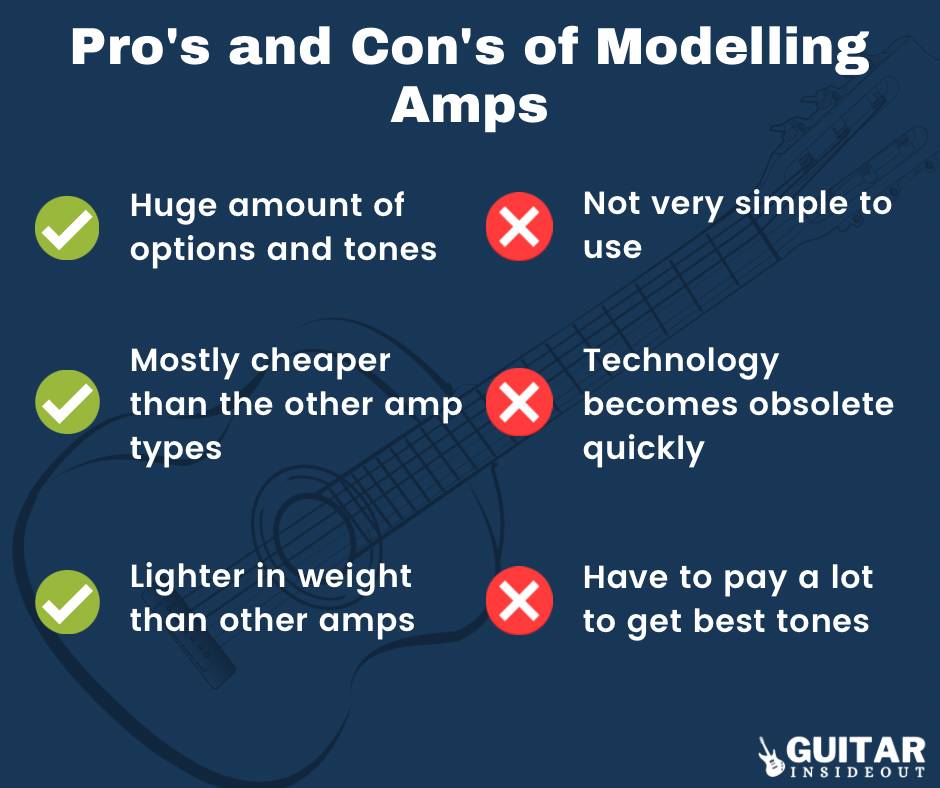
Hybrid
Hybrid amps are, as their name implies, a hybrid of different types of amplifiers and the technology they use.
Hybrids combine tubes with solid state or modelling tech. A great idea in theory as you get the advantages of both and they cancel out or mitigate the negatives.
But in practice it doesn’t quite work out. In fact hybrid amps have never really taken off. At least not in a big way.
To be honest I’m not entirely sure why. It might be that we, the consumers, have become so fixated on the idea of “proper tube amps” that anything other than that doesn’t cut it.
So only the fully fledged, real thing will sell. Which is silly because a lot of guitarists run tube amps with the volume low so the power tubes aren’t breaking up anyway and they get their gain from the preamp.
So a hybrid would seem perfect: one that uses a tube preamp to clip, and the preamp tubes last longer than power tubes and need less replacing, and then have a solid state power section which is going to be lighter because there’s no need for an output transformer. Best of both worlds!
For whatever reason though it’s never taken off and amp manufacturers haven’t really prioritized them. There’s never really been a standout hybrid amp that’s taken the guitar world by storm.
Maybe the Orange Micro Terror? But that’s not really a proper gigging amp. Blackstar have got quite a few hybrids too but again they haven’t really taken off.

Orange Micro Terrror 20W Mini Hybrid Guitar Head
Perhaps the problem with hybrid amps is that they end up being quite good without ever really excelling in any area. So a tube amp still sounds better and solid state is more convenient, whereas the hybrid can’t quite match the tone of the full tube and isn’t quite as light and convenient as the solid state. Jack of all traits, master of none.
How do They Sound
Hybrid amplifiers do a decent job of getting close to a tube sound. Or at least some of them do.
You can get a nice bit of ‘tone flavor’ from a hybrid. But if you want the real thing you’ll notice the difference.
A single tube placed in a hybrid amp isn’t going to make it sound like a tube amp. That might not matter – if it sounds good then who cares.
But it means a hybrid can’t really replace a tube amp.
Weight
Lighter than a tube amp, heavier than digital modellers and solid state amps is where hybrids sit. Removing some of the parts of a full tube amp reduces the weight but they’ve still got more than a standard solid state.
Reliability
Due to the way they’re made hybrid amps are usually as reliable as solid state or digital amps. As they tend to have some form of tubes it does make them a little more liable to break or be more fragile though.
How Much Do They Cost
As there aren’t that many hybrids even on the market now it’s not that easy to talk about their price. But for the most part they are at the lower end of the amplifier market and so don’t cost too much.
Combo and Heads and Cabinets
Amps of every type come in different configurations – combos or heads and cabinets (or ‘stacks’ as they’re sometimes called).
A combo combines the amplifier with the speaker in one unit.
A head and cabinet has the amplifier and speaker separate connected by an external cable.
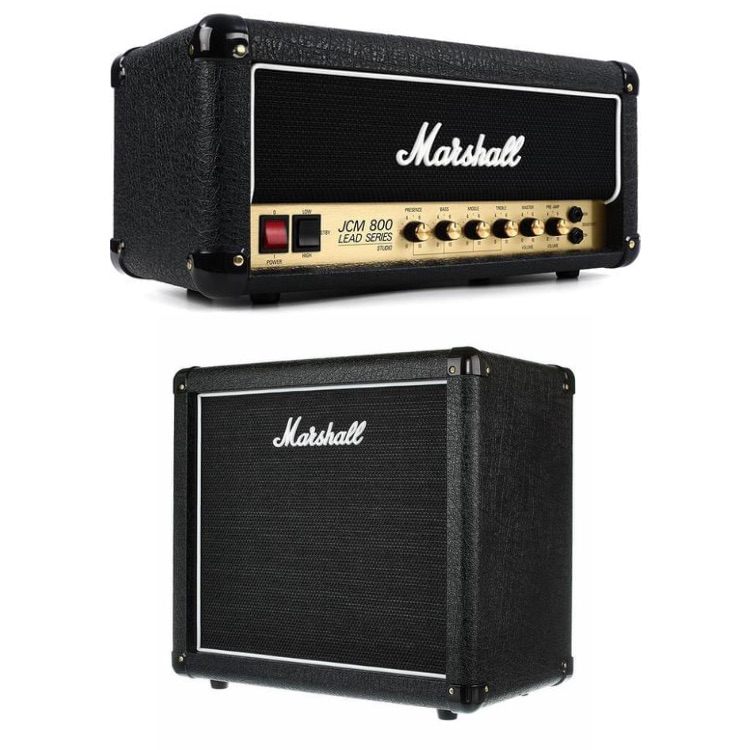
Combos
Combos are the traditional form of amplifier. They were intended to be easy to move and not too large back when amps weren’t as powerful as they are today.
Combos are still very popular though. Amp manufacturers produce combos as well as head and cabinet versions of most of their amps. This gives guitarists the choice of whichever they prefer or suits their situation.
Head and Cabinet
Heads and cabinets were first introduced as amplifiers became a lot more powerful and artists needed more volume. When bands began to play larger venues and stadiums they needed more than a single combo amp. They needed greater speakers and more volume.
So it made sense to separate the amp and speakers, allowing for greater portability and the option to have the amplifier head match up with different speaker configurations.
You now weren’t limited to the speaker configuration that came in your combo. With a single cable the amp head could be paired with a 1×12, 2×12 and even 4×12 speaker cabinet, to name only a few.
It also makes transporting your amp much easier but also gives you option to mix and match amp heads with different types of cabs. Some speakers suit certain music styles better than others so being able to switch between them gives you even more flexibility.
Speakers
Even if you’re using a head and cabinet that cabinet will come with one or more speakers in it. The number and type of speakers has a fairly important role in the sound and tone the amplifier produces.
Speakers come in a few different sizes: 6″, 8″, 10″ and 12″. 10″ and 12″ are the most commonly found in guitar amps although some of the smaller practice amps have 6 or 8″ speakers.
The bigger the speaker the louder and fuller the sound will be. You might read or hear smaller speakers or amps described as being “boxy”, which means their sound lacks depth.
But smaller speakers suit smaller combos. So it comes down to what you like and what’s convenient.
You can also swap speakers in combos and cabinets quite easily. Many guitarists will buy an amp then do a speaker “upgrade” and replace the stock one it comes with for a speaker or their choice.
FAQ
Are Valve and Tube Amps the Same?
Yes, “valve” and “tube” mean the same thing. “Valve” is the English term and “tube” is the American and both are referring to the tubes/valves in the amp or the type of amp it is.
Do Guitar Amp Tubes Make a Difference?
Yes, the tubes used in the amp have a direct effect on how it sounds. Different types of tubes suit different tones and styles of music.
Before you go…
For more information about choosing and using an amp try these articles:
Guitar Amplifier Buying Guide: What to Consider
Guitar Amp Controls Explained: A Guide to the Basic Settings
Related Articles
